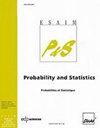Exponential quasi-ergodicity for processes with discontinuous trajectories
IF 0.7
4区 数学
Q4 STATISTICS & PROBABILITY
引用次数: 1
Abstract
This paper tackles the issue of establishing an upper-bound on the asymptotic ratio of survival probabilities between two different initial conditions, asymptotically in time for a given Markov process with extinction. Such a comparison is a crucial step in recent techniques for proving exponential convergence to a quasi-stationary distribution. We introduce a weak form of the Harnack inequality as the essential ingredient for such a comparison. This property is actually a consequence of the convergence property we intend to prove. Its complexity appears as the price to pay for the level of flexibility required by our applications, notably for processes with jumps on a multidimensional state-space. We show in our illustrations how simply and efficiently it can be used nonetheless. As illustrations, we consider two continuous-time processes on [[EQUATION]] that do not satisfy the classical Harnack inequalities, even in a local version. The first one is a piecewise deterministic process while the second is a pure jump process with restrictions on the directions of its jumps.不连续轨迹过程的指数拟遍历性
本文研究了给定具有消光的马尔可夫过程的两个不同初始条件之间的生存概率渐近比值的上界。这种比较是最近证明准平稳分布的指数收敛的关键步骤。我们引入哈纳克不等式的弱形式作为这种比较的基本成分。这个性质实际上是我们要证明的收敛性的一个结果。它的复杂性似乎是为我们的应用程序所需的灵活性所付出的代价,特别是对于在多维状态空间上跳跃的过程。我们在插图中展示了如何简单有效地使用它。作为说明,我们考虑了[[方程]]上的两个不满足经典哈纳克不等式的连续时间过程,即使在局部版本中也是如此。第一个过程是分段确定性过程,而第二个过程是对其跳跃方向有限制的纯跳跃过程。
本文章由计算机程序翻译,如有差异,请以英文原文为准。
求助全文
约1分钟内获得全文
求助全文
来源期刊

Esaim-Probability and Statistics
STATISTICS & PROBABILITY-
CiteScore
1.00
自引率
0.00%
发文量
14
审稿时长
>12 weeks
期刊介绍:
The journal publishes original research and survey papers in the area of Probability and Statistics. It covers theoretical and practical aspects, in any field of these domains.
Of particular interest are methodological developments with application in other scientific areas, for example Biology and Genetics, Information Theory, Finance, Bioinformatics, Random structures and Random graphs, Econometrics, Physics.
Long papers are very welcome.
Indeed, we intend to develop the journal in the direction of applications and to open it to various fields where random mathematical modelling is important. In particular we will call (survey) papers in these areas, in order to make the random community aware of important problems of both theoretical and practical interest. We all know that many recent fascinating developments in Probability and Statistics are coming from "the outside" and we think that ESAIM: P&S should be a good entry point for such exchanges. Of course this does not mean that the journal will be only devoted to practical aspects.
 求助内容:
求助内容: 应助结果提醒方式:
应助结果提醒方式:


